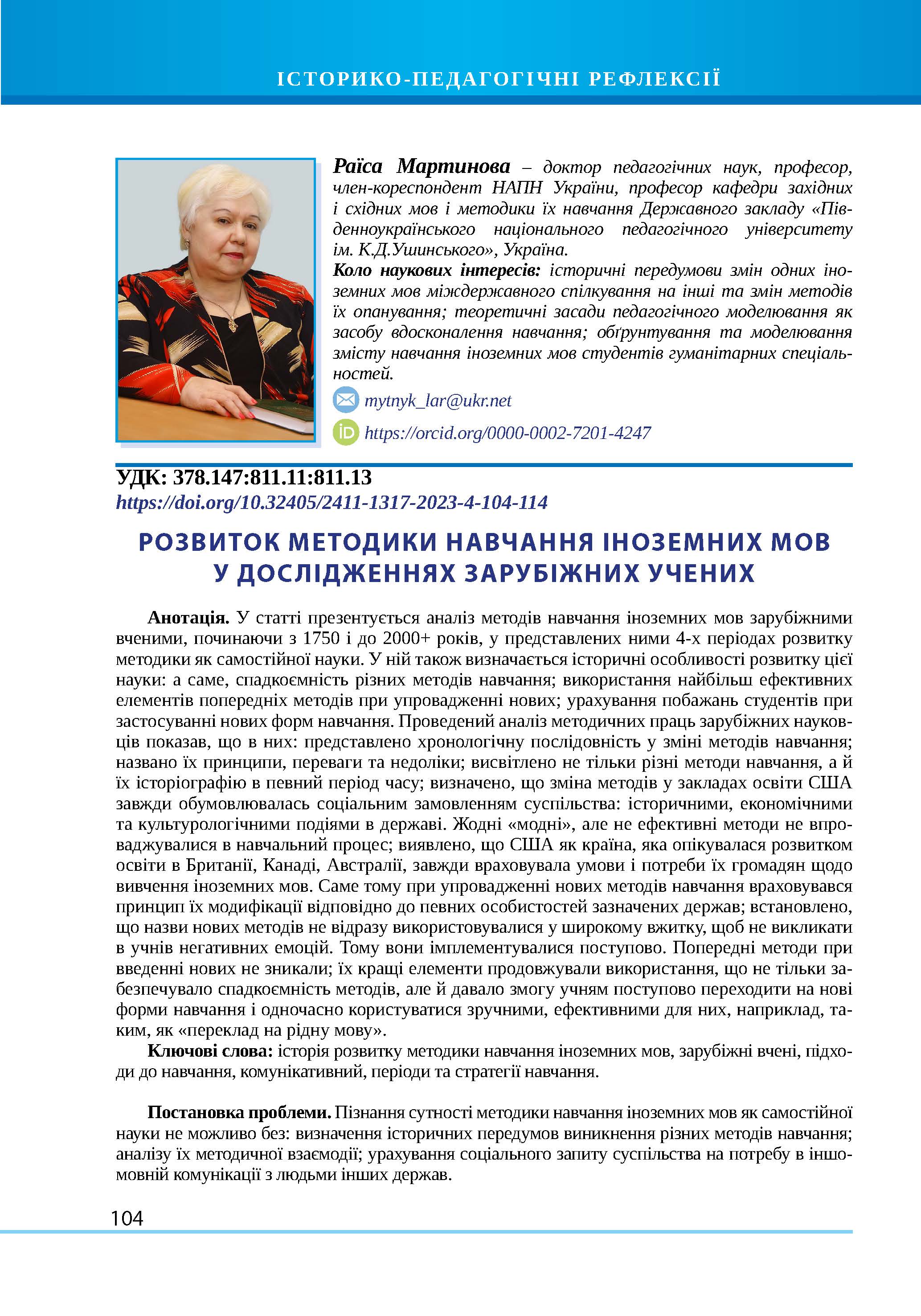Abstract
The article presents the analysis of the methods of teaching foreign languages developed by foreign scholars, starting from 1750 and up to 2000+. The analysis embraces 4 periods of the development of methods of teaching as an independent science. The author of the article determines the historical features of the development of methods of teaching: namely, having a succession of different teaching methods; using the most effective elements of the previous methods when implementing the new ones; taking into account the students’ preferences when using new learning tools. The analysis of the methodological works of foreign scholars showed that these works: present a chronological sequence in the change of teaching methods; name their principles, advantages and disadvantages; highlight not only different teaching methods, but also their historiography in a certain period of time. In the research it is stated that the change of methods in the educational institutions of the USA has always been determined by the social order of the society; historical, economic and cultural events in the country. The methods, which were newly brand but turned out ineffective, were not introduced into the educational process. It was found out that the USA, as a country that took care of the development of education in Britain, Canada, and Australia, always took into account the conditions and needs of the citizens of these countries concerning the study of foreign languages. That is why, when introducing new teaching methods, the principle of their modification was taken into account in accordance with certain specific features of the above mentioned countries. It was also established that the names of the new teaching methods were not immediately widely used in the educational process in order not to cause negative emotions in students. Therefore, they were implemented gradually. The previous methods did not disappear when new ones were introduced. Their best elements continued to be used. Such step ensured the succession of methods and also enabled students to switch gradually to new forms of learning and simultaneously use convenient and effective forms for learners, for example, such as translation into their native language.
References
Berlitz, M. D. (1926). The Berlitz Method for teaching modern languages. English. Part 246-th еdition. London; Paris.
Cook, V. (2016). Second Language Learning and Language Teaching. Routledge.
Doff, S. (2002). Englischlernen zwischen Tradition und Innovation. Fremdsprachenunterricht für Mädchen im 19. Jahrhundert. Munich: Langenscheidt-Longman.
Evans, S. (2003). The Introduction and Spread of English-language Education in Hong Kong (1842–1913): A Study of Language Policies and Practices in British Colonial Education. PhD thesis, University of Edinburgh.
Franz, J. (2005). Englischlernen für Amerika. Sprachführer für deutsche Auswanderer im 19. Jahrhundert. Munich: Langenscheidt.
Fries, Ch. C. (1945). Teaching and learning English as a foreign language. Michigan : University of Michigan Press.
Hornby, A. S. (1950). The situational approach in language teaching. A series of three articles in English Language Teaching, 4, 98-104.
Howatt, A. & Smith R. (2014). The History of Teaching English as a Foreign Language, from a British and European Perspective. Language & History, 57(1), 75-95.
Hunter, D. & Smith, R. (2012). Unpackaging the Past: ‘CLT’ through ELTJ Keywords. ELT Journal, 66(4), 430–439.
Jespersen, O. (1904). How to Teach a Foreign Language. London: Swan Sonnenschein.
Kantor, J. R. (1936). An objective psychology of grammar. Indiana University Publications.
Kolb, E. (2013). Kultur im Englischunterricht. Deutschland, Frankreich und Schweden im Vergleich (1975–2011). Heidelberg: Winter.
Lado, R. (1964). Language teaching: a scientific approach. New York : MkGraw-Hill.
Larsen-Freeman, D. (2011). Techniques and Principles in Language Teaching (3rd edition). Oxford University Press.
Lehberger, R. (1986). Englischunterricht im Nationalsozialismus. Tübingen: Stauffenburg.
Macht, K. (1990). Methodengeschichte des Englischunterrichts. 3 vols. Augsburg: University of Augsburg.
Martynova, R. Yu. (2023). Contemporary scientists’ linguo didactic research works on the history of the development of foreign language teaching methodology as an independent science. Ukrainian educational journal, 3, 163-174.
Palmer, H. E. (1924). Memorandum on Problems of English Teaching in the Light of a New Theory. Tokyo: Institute for Research in English Teaching.
Palmer, H. E. (1923). The Oral Method of Teaching Languages. Cambridge: Heffer.
Ruisz, D. (2014). Umerziehung durch Englischunterricht? US-amerikanische Reeducation-Politik, neuphi_lologische Orientierungsdebatte und bildungspolitische Umsetzung im nachkriegszeitlichen Bayern (1945–1955). Münster: Waxmann.
Smith, R. C. (2005). An Investigation of the Roots of ELT, with a Particular Focus on the Work of Harold E. Palmer. Phd thesis, University of Edinburgh.
Sweet, H. (1894). The practical study of languages. Oxford: Oxford University Press.
Viëtor, W. (1902). Die Methodik des neusprachlichen Unterrichts: ein geschichtlicher Überblick in vier Vorträgen. Leipzig: Teubner.

This work is licensed under a Creative Commons Attribution-NonCommercial-ShareAlike 4.0 International License.


